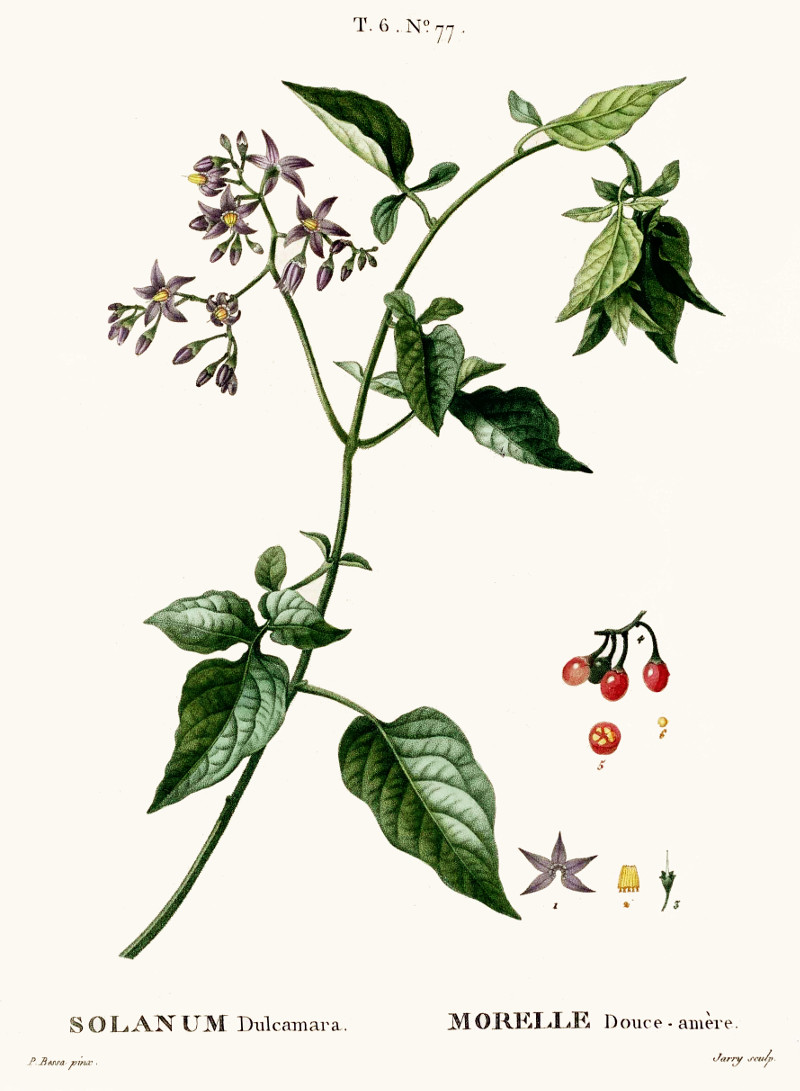Solanum dulcamara L. - syn. Solanum lyratum Thunb., Solanum depilatum Kitag. - Solanaceae
bitter nightshade, (European) bittersweet, climbing nightshade, woody nightshade, Bittersüßer Nachtschatten
Deciduous woody climber, up to 2m high, native to Europe, North Africa, Asia, India, North America; leaves ovate-lanceolate, some top ones hastate (arrow-head-like, with two lobes); flowers violet-blue, 5-lobed; berries ovoid, bright red when mature.
Ingestion of the red berries by kids may lead to solanine poisoning.
[A fatal case of solanine poisoning., Alexander, R.F., Forbes, G.B., Hawkins, E.S., British medical journal, 2(4575), 1948, 518] http://www.ncbi.nlm.nih.gov/pmc/articles/PMC2091497/pdf/brmedj03694-0020a.pdf
„The aglycon solanidine was considerably less toxic than the glycoside. In unanesthetized rabbits, solanine produced tachycardia, tachypnea, and terminal bradypnea… Death resulting from solanine intoxication appeared to be caused by central nervous system depression because of the initial disappearance of EEG signals followed by cessation of respiration and terminal loss of ECG signals. Solanine and solanidine are very similar to cardiac glycosides with respect to effect on the heart. They produce positive inotropic action in the isolated frog ventricle. Toxic doses administered iv in rabbits produced ventricular extrasystoles and terminal ventricular fibrillation. Solanine had roughly the potency of the reference compound, K-strophanthoside, whereas solanidine was about one-fifth as active.“
[Pharmacology of solanine., Nishie, K., Gumbmann, M.R., Keyl, A.C., Toxicology and applied pharmacology, 19(1), 1971, 81-92]
The dried two- or three year old stems (Dulcamarae stipites) are used traditionally (orally, as infusion/decoction) in the supportive treatment of chronic eczema and pruritic skin conditions, catarrh, bronchitis, asthma and rheumatism. „Depending on the source, the main alkaloids are glycosides of soladulcidine, tomatidenol or solasodine. The saponins are yamoginosides A and B…“
[Medicinal Plants of the World. Ben-Erik Van Wyk and Michael Wink, Pretoria 2004, 304]

Duhamel du Monceau,H.L., Traité des arbres et arbustes, Nouvelle édition [Nouveau Duhamel], vol.6, t.77 (1815) [P.Bessa]
http://plantgenera.org/species.php?id_species=956124
